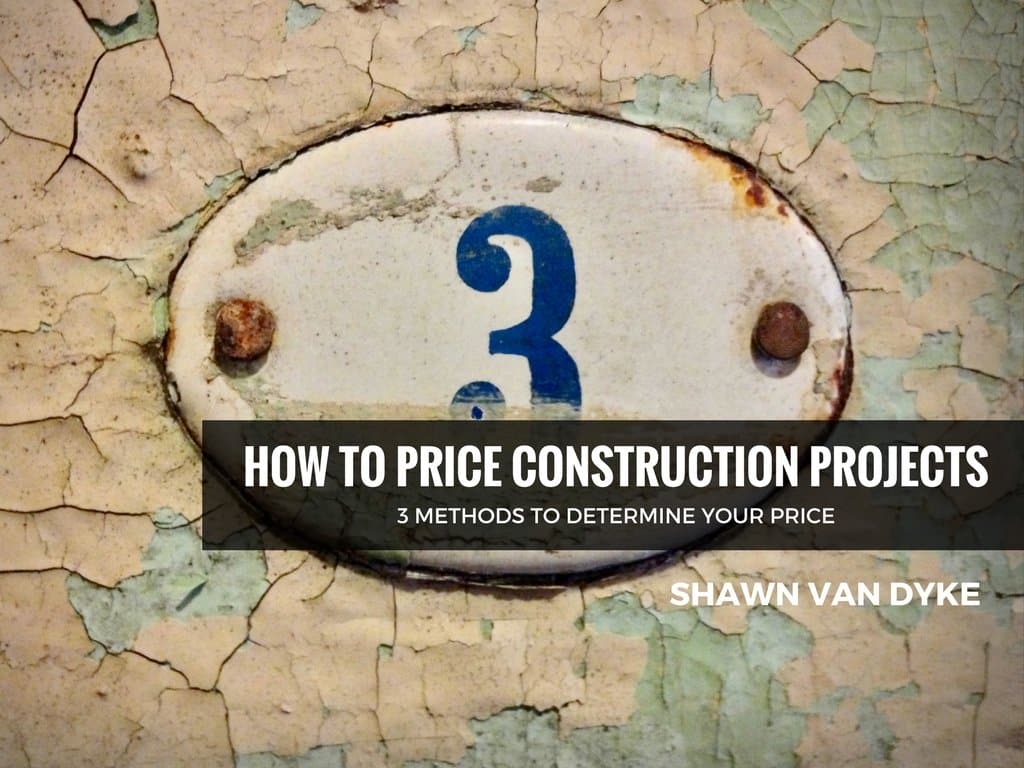Built to Build: Blog
PRICING CONSTRUCTION PROJECTS

CLICK BELOW TO LISTEN TO THE BLOGCAST OF THIS POST.
As I have written before, there’s only one way to be successful in pricing construction projects — know your numbers.
PRICING STRATEGIES FOR CONSTRUCTION PROJECTS
Construction is a cost-based business. You have to know your costs for any given project, and mark up those costs by the appropriate amount to determine a price.
In this article for FineHomebuilding.com, I review three pricing strategies to ensure you are making a profit in your construction business.
Your price (and therefore your markup) must be high enough to cover your expenses and leave a profit.
Here are the equations you must know in order to determine your price and to ensure that price yields a profit:
PRICE = COSTS x MARKUP
PROFIT (NET PROFIT) = INCOME – COGS – EXPENSES
Those are the two key equations you must know.
Now let’s define some terms.
COSTS are the Cost Of Goods Sold (COGS) and these are the items you buy, markup and sell to your clients.
These are the items that you leave out in the field.
For a construction business the COGS are usually LABOR, MATERIALS, SUBCONTRACTORS, and EQUIPMENT.
EXPENSES are everything else.
For example:
Your cell phone isn’t something that you buy and sell to your clients. Your cell phone is not a COGS; it is an EXPENSE.
It’s very hard to operate your business without a cell phone, therefore your clients need to pay for that EXPENSE.
INCOME is defined as the total amount of money you receive for the work you perform or the sum of all the prices of all the individual jobs you produce in a given time period.
Now that we have those terms defined, let’s look at 3 different ways to calculate the price for your construction projects.
If you are priced correctly, then you have the best opportunity to make a profit.
Pricing Method #1: The Cost-Based Method
PRICE = COSTS x MARKUP FACTOR
Step 1. Determine your costs. Determine the COSTS (COGS) of your LABOR, MATERIALS, SUBCONTRACTORS, and EQUIPMENT.
Step 2. Multiply your COSTS by your MARKUP FACTOR to determine your price.*
*If your markup is 30%, then the markup factor is 1.3.
Don’t guess at your COSTS (COGS). Calculate what these COSTS are.
If you are starting out, you may have no idea what things costs.
Do the hard work and figure this out.
Don’t guess.
Call other professionals.
Do your research.
At the risk of sounding self-serving, hire a coach or get a mentor.
Surround yourself with people smarter than you and with more experience.
Ask questions.
If you don’t know what you markup should be, then read this article.
Pricing Method #2: The Price Method
Let’s assume that you know you can sell a product or service for a certain PRICE, but you aren’t sure if the PRICE is high enough to cover your COSTS.
Then use the same equation from Method #1.
It will be formatted in this way:
PRICE / MARKUP FACTOR = COSTS
For example:
If you “know” that a project should be priced at $20,000 and your MARKUP FACTOR is 1.5, then you can calculate the costs of the project by dividing the PRICE by the MARKUP FACTOR.
COSTS = $20,000/1.5 = $13,333
Now calculate the COSTS (COGS) for this project – cost of LABOR, MATERIALS, SUBS AND EQUIPMENT.
If the COGS exceed $13,333, then multiply the calculated COGS by 1.5, and sell that number as the PRICE.
Pricing Method #3: The Margin Method
Let’s assume that you have calculated your COSTS and you want to determine the PRICE based on an assumed MARGIN.
The equation for this method is:
PRICE = COSTS / (1-MARGIN)
If your calculated costs are $10,000 and the MARGIN you need to make is 40%, then the equation looks like this:
PRICE = $10,000 / (1 – 0.40) = $16,667.
This pricing method is useful when your expenses increase because of the growth of the business, and you want to determine the new PRICE at which you need to sell a project.
The methods listed above are 3 ways to calculate the same result – PRICE.
Profit must be built into everything you build. The only way to realize a profit is to calculate your COSTS and apply the appropriate MARKUP to yield the MARGIN that you need to pay for your EXPENSES and leave you with a NET PROFIT.
If you want to streamline your construction business and DOUBLE your profits next month…

Shawn Van Dyke is a construction industry consultant, business coach, and mentor to skilled trade business owners. He is a Brand Ambassador for Fine Homebuilding, travels across the US as a keynote speaker, seminar presenter, and the author of The Paperwork Punch List: 28 Days to Streamline Your Construction Business.
WANT SHAWN TO SPEAK AT YOUR EVENT OR TRAIN YOUR TEAM?
